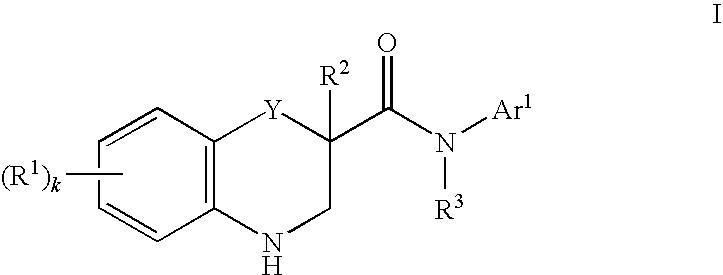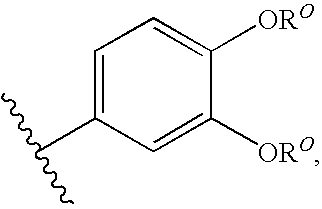Modulators of cystic fibrosis transmembrane conductance regulator
a technology of transmembrane conductance and cystic fibrosis, which is applied in the field of modulators of cystic fibrosis transmembrane conductance regulators, can solve the problems of imbalance in ion and fluid transport, debilitating and fatal effects of cf, and reducing anion transpor
- Summary
- Abstract
- Description
- Claims
- Application Information
AI Technical Summary
Benefits of technology
Problems solved by technology
Method used
Image
Examples
example 1
Preparation of N-(4-cyclopentyl-5-hydroxy-2-(3-(methylamino)prop-1-ynyl)phenyl)-6-(trifluoromethoxy)-3,4-dihydro-2H-benzo[b][1,4]oxazine-2-carboxamide (Compound 98, Table 1)
[0671]
[0672]6-(Trifluoromethoxy)-3,4-dihydro-2H-1,4-benzoxazine-2-carboxylic acid (490 mg, 1.86 mmol) and (5-amino-4-bromo-2-cyclopentyl-phenyl)methyl carbonate (585 mg, 1.86 mmol) were dissolved in 2-methyltetrahydrofuran (13 mL). Pyridine (376 μL, 4.65 mmol) and T3P (2960 mg, 2.8 mL of 50% w / w solution, 4.66 mmol) were added and the reaction was stirred for 1 h at room temperature. Purification by silica gel chromatography (10-75% ethyl acetate / hexanes) yielded 4-bromo-2-cyclopentyl-5-(6-(trifluoromethoxy)-3,4-dihydro-2H-benzo[b][1,4]oxazine-2-carboxamido)phenyl methyl carbonate (802 mg, 77% yield). LC / MS m / z 560.2 [M+H]+.
[0673]4-Bromo-2-cyclopentyl-5-(6-(trifluoromethoxy)-3,4-dihydro-2H-benzo[b][1,4]oxazine-2-carboxamido)phenyl methyl carbonate (812 mg, 1.45 mmol), triethylamine (2.0 mL, 14.52 mmol), prop-2-yn...
example 2
Preparation of N-(4-methyl-2-(3-morpholinoprop-1-ynyl)phenyl)-6-(trifluoromethoxy)-3,4-dihydro-2H-benzo[b][1,4]oxazine-2-carboxamide (Compound 100, Table 1)
[0675]
[0676]6-(Trifluoromethoxy)-3,4-dihydro-2H-1,4-benzoxazine-2-carboxylic acid (600 mg, 2.28 mmol) and 2-bromo-4-methyl-aniline (424 mg, 286 μL, 2.28 mmol) were dissolved in 2-methyltetrahydrofuran (7 mL) and pyridine (461 μL, 5.70 mmol). T3P (2902 mg, 2.7 mL of 50% w / w solution, 4.56 mmol) was added and the reaction was stirred for 30 min at room temperature. Purification by silica gel chromatography (10-100% ethyl acetate / hexanes) provided N-(2-bromo-4-methylphenyl)-6-(trifluoromethoxy)-3,4-dihydro-2H-benzo[b][1,4]oxazine-2-carboxamide (743 mg, 76% yield). LC / MS m / z 432.4 [M+H]+.
[0677]Prop-2-yn-1-ol (195 mg, 202 μL, 3.48 mmol), N-(2-bromo-4-methyl-phenyl)-6-(trifluoromethoxy)-3,4-dihydro-2H-1,4-benzoxazine-2-carboxamide (300 mg, 0.69 mmol), PdCl2(PPh3)2 (122 mg, 0.17 mmol), CuI (19.88 mg, 0.10 mmol), and triethylamine (970 μ...
example 3
Preparation of N-(4-cyclopentyl-5-hydroxy-2-((4-methylpiperazin-1-yl)methyl)phenyl)-3,4-dihydro-2H-benzo[b][1,4]oxazine-2-carboxamide (Compound 52, Table 1)
[0680]
[0681]To (4-methylpiperazin-1-yl)methyl-(trifluoro)borane (10 mg, 0.053 mmol), Pd(OAc)2, (0.3 mg, 0.0016 mmol), X-Phos (1.5 mg, 0.003 mmol), and Cs2CO3 (51 mg, 0.15 mmol) was added dropwise 4-bromo-2-cyclopentyl-5-(3,4-dihydro-2H-benzo[b][1,4]oxazine-2-carboxamido)phenyl methyl carbonate (25 mg, 0.053 mmol) in THF / water (10:1, 600 μL) under N2 atmosphere. The reaction was heated under microwave irradiation at 100° C. for 45 min. The reaction was cooled to room temperature and treated with 1M NaOH. After 10 min the mixture was filtered and purified by HPLC (10-99% CH3CN / 0.05% TFA) to provide N-(4-cyclopentyl-5-hydroxy-2-((4-methylpiperazin-1-yl)methyl)phenyl)-3,4-dihydro-2H-benzo[b][1,4]oxazine-2-carboxamide trifluoroacetate (1.6 mg, 14% yield). LC / MS m / z 451.5 [M+H]+.
PUM
| Property | Measurement | Unit |
|---|---|---|
| temperature | aaaaa | aaaaa |
| pH | aaaaa | aaaaa |
| temperature | aaaaa | aaaaa |
Abstract
Description
Claims
Application Information
 Login to View More
Login to View More - R&D
- Intellectual Property
- Life Sciences
- Materials
- Tech Scout
- Unparalleled Data Quality
- Higher Quality Content
- 60% Fewer Hallucinations
Browse by: Latest US Patents, China's latest patents, Technical Efficacy Thesaurus, Application Domain, Technology Topic, Popular Technical Reports.
© 2025 PatSnap. All rights reserved.Legal|Privacy policy|Modern Slavery Act Transparency Statement|Sitemap|About US| Contact US: help@patsnap.com



